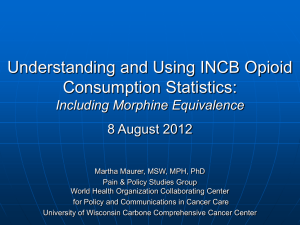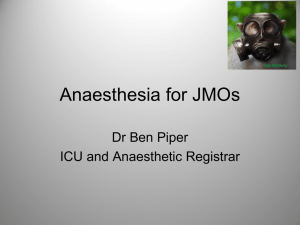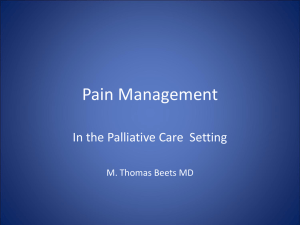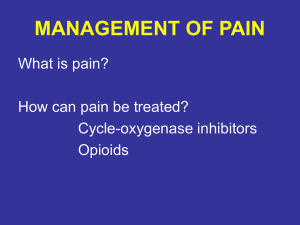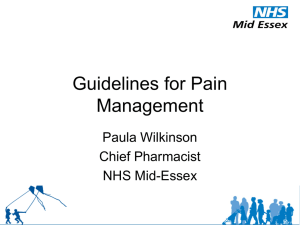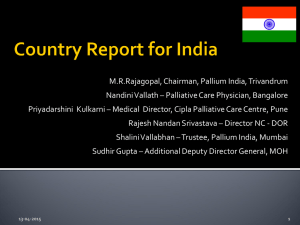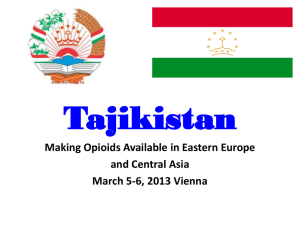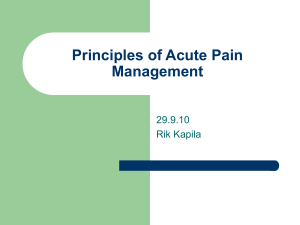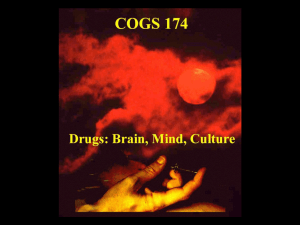New INCB/WHO Guidelines - Martha Maurer & Aaron Gilson
advertisement
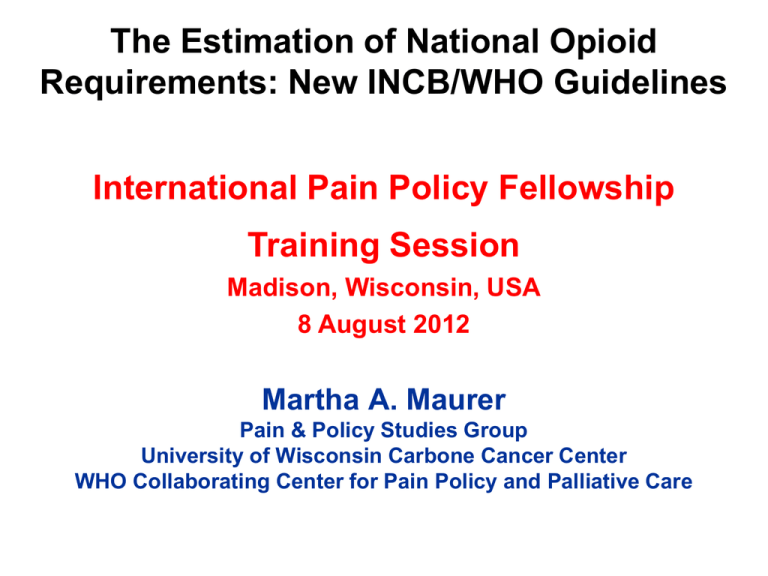
The Estimation of National Opioid Requirements: New INCB/WHO Guidelines International Pain Policy Fellowship Training Session Madison, Wisconsin, USA 8 August 2012 Martha A. Maurer Pain & Policy Studies Group University of Wisconsin Carbone Cancer Center WHO Collaborating Center for Pain Policy and Palliative Care The Single Convention establishes two mechanisms: (1) The estimates system for narcotic drug requirements, and (2) The statistical returns system for narcotic drugs Drug Requirements Definition The Single Convention (Article 19) defines drug requirements as the quantities of drugs that will be used in the country for medical and scientific consumption, as well as for the manufacturing of other licit preparations. How are estimated requirements established for a country? • Governments estimate amount of controlled substances needed to satisfy all medical and scientific requirements for the next year • Submit Estimates to INCB on Form B by June 30th of each year for the following year (i.e., by 30 June 2012 for 2013 estimated requirements) • INCB evaluates, confirms and publishes the estimate for each Government • Government may then manufacture or import controlled substances within that amount to distribute to medical facilities for the treatment of patients Who is responsible? IV. TABLE 1. COMPETENT NATIONAL AUTHORITIES ALBANIA KYRGYZSTAN Ministry of Health Department of Pharmacy Tirana Albania State Service on Drugs Control of the Kyrgyz Republic 80 Toktogula Street Bishkek 720021 The Kyrgyz Republic Phone: 355 - 42 - 34636 FAX: 355 - 42 - 28303 Phone: 996 - 312 - 662217 Fax: 996 - 312 - 625143 Web: www.gskn.kg BANGLADESH SRI LANKA Department of Narcotics Control (DNC) Ministry of Home Affairs Wage Earners Hostel Complex (Level – 8) 71-72, Old Elephant Road (Eskaton Garden), Ramna Dhaka 1000, Bangladesh Medical Supplies Division 357, Deans Road Colombo 10 Sri Lanka Phone: 880 - 2 - 831 2131 Fax: 880 - 2 - 831 1155 E-mail: dgdnc@bttb.net.bd Phone: 94 - 1 - 694 - 111 Fax: 94 - 1 - 697 - 096 INDIA UKRAINE Central Bureau of Narcotics Ministry of Finace 19, The Mall Morar Gwalior 474006 Madhya Pradesh India State Service on Drugs Contol Prospect Chervonozoryanyi 51 03680 Kiev Phone: 91 - 751 236 8996 Phone: 91 - 751 236 8997 Phone: 91 - 751 236 8121 Fax: 91 - 751 236 8111 Fax: 91 - 751 236 8577 Email: narcom@sancharnet.in Phone: 380 - 44 - 275 - 6814 Fax: 380 - 44 - 275 - 4287 E-mail: info@narko.gov.ua Web: www.narko.gov.ua Published Estimates for 2012 http://www.incb.org/incb/narcotic_drugs_estimates.html Estimated Requirements - Morphine, 2012 Country Albania Bangladesh India Kyrgyzstan Sri Lanka Ukraine Est. in grams* 3,500 100,000 9,743,726 3,500 16,000 62,840 Source: * INCB Estimated World Requirements for 2012 report (June 2012 update) ** CIA World Factbook (July 2011 estimates) Population** 3,002,859 161,083,804 1,205,073,612 5,496,737 21,481,334 44,854,065 Supplementary Estimates • Single Convention authorizes Governments to submit a supplementary estimate • Government should include explanation of why an increase is needed • Can be submitted at any time, and can be approved quickly by INCB when requested Reasons for not submitting estimated requirements Governments lack appropriate methods and procedures for estimating opioid requirements Governments do not allocate sufficient personnel or resources to administer the technical function of estimating drug requirements Why are Estimates of opioids important for the INCB? “Governments and the [International Narcotics Control] Board need to have accurate information about medical needs for narcotic drugs. In the case of narcotic drugs that are opiates, it is particularly important to accurately estimate all medical needs because the Board must make arrangements well in advance to cultivate a sufficient quantity of poppy plants.” (p. 1) (INCB, 1996) Related Issues Impacting Estimates Cost of purchasing, importing medicines Difficulty finding an interested supplier, due to small profit margin for certain low-cost opioids such as IR oral morphine Difficulty identifying Exporter/Supplier with affordable prices, appropriate formulations Challenges in identifying specific formulations and amounts of medicines needed http://www.incb.org/incb/en/guide-on-estimating-requirements.html • New Guide published 2012 • Joint WHO/INCB effort • Purpose to assist Governments in accurately estimating requirements Estimated Requirements vs. Need for Controlled Medicines Estimated Requirements: quantities necessary to provide medical treatment through existing health-care infrastructure Needs: quantities necessary to provide medical treatment for all health problems in country Methods for Estimating Opioid Requirements 1) Consumption–based method 2) Service–based method 3) Morbidity–based method International Narcotics Control Board and World Health Organization. Guide on Estimating Requirements for Substances under International Control. Vienna, Austria: United Nations; 2012. http://www.incb.org/incb/en/guideon-estimating-requirements.html 1) Consumption–based method Based on use of opioids over recent years Developed using an average of the amounts consumed in recent years Example: Calculating morphine requirement of country X for 2013 Year Morphine use (kg) 2010 17 2011 15 2012 18 Average = 16.7 kg + (10%) 1.67 kg 18.4 kg Estimated Morphine Requirement for 2013 1) Consumption–based method Appropriate to use when: Limitations: reliable data about recent opioid consumption can be collected, Does not provide a basis for improving rational use and accuracy, demand for health-care services has reached a relatively steady level, stock-outs, losses, and waste may reduce accuracy, and well-functioning supply management system, and incomplete data due to poor stock management, inadequate record-keeping or reporting to authorities use of controlled substances is rational 2) Service–based method Calculates requirements for controlled substances based on current levels of use of each substance (for all indications) in a sample of standard healthcare facilities. Data from standard facilities extrapolated to calculate the requirements for other similar facilities Targets health services available and takes into account current treatment levels o may reflect financial / administrative constraints in existing healthcare system 2) Service-based method Example: Total annual estimated morphine requirement for country x Type of Facility Total number of facilities in country Expected number of patient contacts at all facilities Avg. morphine consumption Regional Cancer Center 5 90,000 5 kg 450 kg Nat’l Cancer Center 1 40,000 4.375 kg 175 kg 10 50,000 6 kg 300 kg Hospice Total per 1,000 patient contacts (at standard facility) Total requirement per facility type 925 kg 2) Service–based method Appropriate to use when: Limitations: prescribing, administering and dispensing patterns in standard facilities are rational, may not take into account medical needs of patients that cannot be met due to constraints of existing health system, pattern of morbidity in standard facilities is representative of the region/country detailed data on patient morbidity and standard treatment guidelines are not available. inappropriate patterns of prescribing, administering, dispensing in standard facilities will be perpetuated in calculations, and limitations of healthcare system (frequent stock outs) may make it difficult to select valid standard facilities 3) Morbidity–based method Based on frequency of diseases and health problems (morbidity) and on accepted treatment norms Advantage – draws attention to magnitude of the health problem, (i.e., unrelieved pain) Disadvantage – will likely overestimate the quantities that would actually be consumed Morbidity-based Estimate for Morphine: example standard treatment norm For Cancer patients: # annual deaths x 80% requiring EOL care with oral morphine x 90 days x 60-75mg per day For AIDS patients: # annual deaths x 50% requiring EOL care with oral morphine x 90 days x 60-75 mg per day Foley KM, Wagner JL, Joranson DE, Gelband H. Pain control for people with cancer and AIDS. In: Jamison DT, Breman JG, Measham AR, Alleyne G, Claeson M, Evans DB et al., eds. Disease Control Priorities in Developing Countries. 2nd ed. New York, NY: Oxford University Press; 2006:981-993. http://files.dcp2.org/pdf/DCP/DCP52.pdf 3) Morbidity-based method Example: morphine requirement for late-stage cancer pts. in country x No. of late-stage cancer patients Total No. of facilities in country Nat’l approx. of late-stage cancer patients for each type of facility 80% of patients who need pain treatment Avg. amount of morphine per pt. for 90-day standard course of treatment Total qty. of morphine consumed by all late-stage cancer patients Nat’l Referral hospital with PC unit 1,000 1 1,000 800 6,075 mg 4.86 kg Regional hospital with PC unit 500 5 2,500 2,000 6,075 mg 12.15 kg Hospice with homebased care 300 10 3,000 2,400 6,075 mg 14.58 kg Sample Facility Total 31.59 kg 3) Morbidity-based method Example: morphine requirement for late-stage HIV/AIDS pts. in country x No. of late-stage cancer patients Total No. of facilities in country Nat’l approx. of late-stage cancer patients for each type of facility 50% of patients who need pain treatment Avg. amount of morphine per pt. for 90-day standard course of treatment Total qty. of morphine consumed by all late-stage HIV/AIDS patients Nat’l Referral hospital with PC unit 1,200 1 1,200 600 6,075 mg 3.65 kg Regional hospital with PC unit 800 5 4,000 2,000 6,075 mg 12.15 kg Hospice with homebased care 500 10 5,000 2,500 6,075 mg 15.19 kg Sample Facility Total 30.99 kg 3) Morbidity-based method Example: morphine requirement for late-stage HIV/AIDS and Cancer pts. in country x Total: late-stage cancer patients 31.59 kg Total: late-stage HIV/AIDS patients 30.99 kg GRAND TOTAL 62.58 kg 3) Morbidity–based method Appropriate to use when: Limitations: patterns of data on past use are unavailable or unreliable, Healthcare infrastructure may not have the capacity to treat all morbidity health services are rapidly changing or new, accurate and complete data on morbidity are available, standard treatment norms have been developed, and promoting a change towards more rational prescribing (according to standard treatment norm). if standard treatment norms are not followed, calculated requirements will not match their use For accuracy, need to have complete morbidity data and standard treatment guidelines. Considerations for ensuring accurate Estimates Goal: To ensure that opioids are safely distributed to patients receiving medical treatment and to avoid large unused inventories and diversion: • Is there an adequate infrastructure to support the use of medications? • Will medicines be appropriately stocked, distributed, prescribed, and dispensed? • Are there trained health care professionals willing to prescribe? • Are there guidelines for safe handling of controlled medicines? What can countries do to improve their estimates system? Decide on appropriate method to develop Estimated Requirement Implement the method Communication between National Competent Authority and Health Professionals Conclusions Estimates are Single Convention obligation Government responsibility for calculating estimated requirements to submit annually to INCB Supplementary Estimates are possible New Guide from INCB/WHO offers information on responsibilities and 3 suggested methods Important to consider current capacity of healthcare infrastructure Thank you! Martha Maurer mamaurer@uwcarbone.wisc.edu Pain & Policy Studies Group WHO Collaborating Center for Pain Policy and Palliative Care www.painpolicy.wisc.edu Estimates: Questions for Discussion • Have the estimates been adequate to satisfy actual needs for pain management? • What sources of information are used? • Has the method been evaluated? • How could the method be strengthened? Guatemala • Since 2006, oral morphine had not been available in public hospitals • Fellow working to improve distribution of morphine supply from Guatemala City to regional hospitals in rural areas, including training and preparation of paperwork to introduce new supply of oral morphine • In early 2009, requested by Government to assist with calculating national estimated requirement for morphine Guatemala • Initially, looked at total population that would need oral morphine for pain relief – proposed to increase estimate to cover 50% of those in need • WHOCC and IAHPC colleagues cautioned against this approach, advised fellow to consider actual need and safe distribution of morphine first • Ultimately considered how many patients were currently being cared for by palliative care units in the country and arrived at a more realistic estimate for morphine
